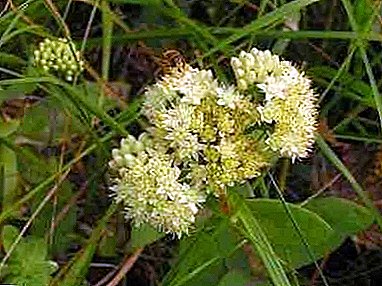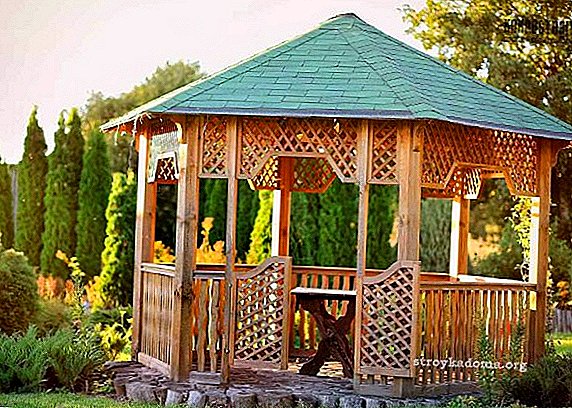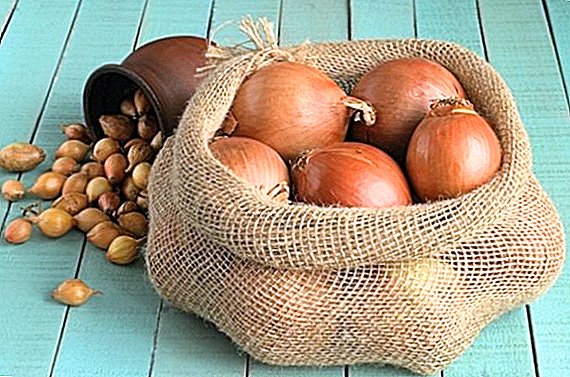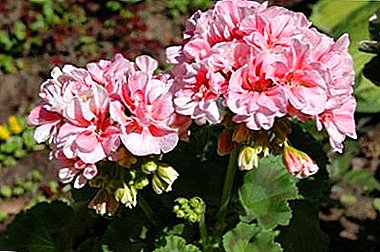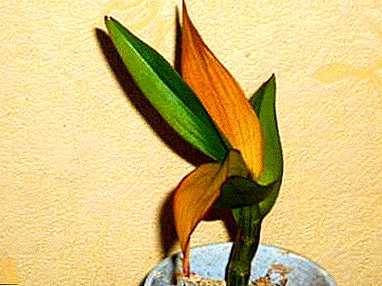
The orchid is a fragrant tropical flower that every hostess dreams to have at home. Dendrobium is the most common species of this plant. At home, this plant is grown by many growers, as it is not difficult.
But it is important to know about the diseases and possible problems that may appear during cultivation. In addition, there are some features in the care of this beautiful flower. Often flower growers, especially beginners, are faced with such a problem as the yellowing of orchid leaves. What if this happened?
How to determine that the flower is sick?
Dendrobium leaves began to turn yellow - this is the first sign that the care of the plant is carried out incorrectly. Wherein such a phenomenon as leaf curling and stem yellowing is common. Determine that the orchid began to fall ill is easy, as the change in the color of the leaves is immediately visible.
Important! When the leaves turn yellow, the flower must be saved, but in order to do this, it is important to determine why the plant started to hurt. And so that this situation does not happen, you need to know the reasons why the orchid begins to turn yellow.
Main reasons
 There are several of the most common causes of yellowing of leaves in dendrobium - high temperature, disturbed or decay of roots, low air humidity, overfeeding. You should not raise a panic if the leaves turned yellow and began to fall off after flowering, as for Orchid Dendrobium Nobile this phenomenon is natural, but if it happened before flowering or in time for it, then you should pay close attention to this.
There are several of the most common causes of yellowing of leaves in dendrobium - high temperature, disturbed or decay of roots, low air humidity, overfeeding. You should not raise a panic if the leaves turned yellow and began to fall off after flowering, as for Orchid Dendrobium Nobile this phenomenon is natural, but if it happened before flowering or in time for it, then you should pay close attention to this.
Despite the fact that growing orchids is troublesome, but in gratitude you can get a magnificent flower with unusual buds. Worth knowing that each individual orchid has its own peculiarities in the care.
There are six groups into which the dendrobium is divided, and each has specific requirements for the air temperature in the room. Therefore, to avoid yellowing of the foliage, you need to create an optimal indoor temperature for the plant. There are heat-loving dendrobiums, and there are those that need to be kept in a cool environment.
For thermophilic varieties the temperature is considered comfortable:
- a period of active development and growth during the day + 20-25 degrees;
- at night 16-21 degrees with a plus;
- during the rest period - in the winter, in the daytime no more than +20 degrees;
- at night no less than +18.
Plants who love cool:
- in the summer, daytime 16-18 ° C;
- at night around 12 ° C;
- winter days around 12 ° C;
- winter nights 8 ° C.
Yellow leaves may be due to rotting roots. As is well known in nature, orchids live on tree trunks, therefore the root system of a flower is in a state free from soil. Even after heavy rains, they dry out very quickly. Therefore, at home it is necessary to prevent moisture in the substrate. Sometimes the cause of yellowing is the old age of the plant.
 Even if an orchid was bought quite recently, there is no guarantee that it did not stand in the store for a long time. Despite the fact that the dendrobium plant is tropical, it does not tolerate direct sunlight. On hot sunny days, the orchid needs to be shaved, otherwise a burn may appear on the leaves and they will turn yellow.
Even if an orchid was bought quite recently, there is no guarantee that it did not stand in the store for a long time. Despite the fact that the dendrobium plant is tropical, it does not tolerate direct sunlight. On hot sunny days, the orchid needs to be shaved, otherwise a burn may appear on the leaves and they will turn yellow.
Pests and insects cause diseases and yellowing foliage. Orchid can be attacked by thrips, aphids, slugs, which can start not only on the stem, but also on the roots.
Important! Lack of moisture, is also the cause of yellowing foliage. Orchid requires timely and stable watering.
Why do changes occur?
Most of them are associated with improper care of the crop, so in order to preserve the health of the plant, it is necessary to determine exactly what caused the pathology and revise the rules for caring for the flower. There are five common situations in which leaves change color.
Aging
Often the orchid begins to bloom only 2-3 years after planting.By this time, the plant has already formed true leaves. The aging process begins to affect the lower part of the plant, that is, those leaves that have grown first. At the same time the flower itself is in a healthy state and has an attractive appearance and continues to bloom. If the leaves turn yellow during the aging process, then there is no need to worry and do something, the leaf will gradually dry and disappear.
Excess moisture
 Proper watering is to install a pot with a plant in a basin of water. At the same time, the planter should be immersed in water in 1/3 part. In this position, the plant is left for 15 minutes, otherwise the soil will become overmoistened.
Proper watering is to install a pot with a plant in a basin of water. At the same time, the planter should be immersed in water in 1/3 part. In this position, the plant is left for 15 minutes, otherwise the soil will become overmoistened.
If watering is excessive, the following occurs: the substrate is saturated with moisture and becomes impermeable to air, the oxygen starvation begins at the root system. The result is a lack of nutrition of the flower itself, making the leaves begin to turn yellow. It should also be borne in mind that bacteria and fungi can develop in a wet substratethat trigger the disease of the plant.
Insufficient watering
Orchid leaves can turn yellow and from a lack of moisture, they gradually wilt, curl and dry. It is worth noting that this is a very rare phenomenon - usually, the hostesses water the flowers as soon as the topsoil dries out. Therefore, before watering the orchid once again, make sure that the reason for yellowing is precisely the lack of water. To do this, just take a few pieces of bark from the substrate, and evaluate the humidity. You can also just take the pot in your hands - if it is light, then the soil is dry.
Sunburn
Often, improper lighting causes yellowing of foliage. - These are sunburns. If the plant is standing on a western or southern window, then in the summer, direct sunlight hits it and burns the plates. A distinctive feature of this phenomenon is that not the whole plate of the sheet turns yellow, but only a part of it. You should not remove the damaged parts - they can recover or fall off on their own, as a last resort, you can make sanitary pruning.
Insects
The ground part of the orchid is very delicate, so various insects and pests often infest on it, which subsequently cause yellowing of the leaf plates.
 pests: Consider the most common
pests: Consider the most common
- Spider mitewhich sucks the sap from the plant, while small yellow dots and thin cobwebs appear on the stems and leaves. We noticed such signs, urgently isolate the diseased plant from other flowers - the tick spreads very quickly. The leaves of a sick flower should be washed with a solution of soap.
- Aphid - in this case, the sheet not only turns yellow, but also becomes sticky. Aphids can be removed with soapy water or spray the plant with Fitoverm.
- Shchitovka - pest, which is very difficult to withdraw. As soon as you notice growths on the leaves of a plant, you need to take action. You can use popular recipes: a solution of ammonia or a mixture of vegetable oil and water. But the most effective drug to combat the shield is Actellic.
What to refrain from?
No need to panic, as soon as the orchid leaves began to turn yellow, just watch it. You can not immediately make mineral fertilizers, as often the process of yellowing begins from overfeeding. It is not necessary to water, if only the top layer of the substrate dries out - there may be stagnant moisture at the bottom of the pot. If the orchid care is proper, then there is a chance that the plant is simply aging, then you should not worry and cut the lower yellowed plates.
What if improvement does not occur?
If all of the above reasons are eliminated, and the leaves still turn yellow, then perhaps the flower began rotting the roots. In this case, you need to transplant the plant, pre-wash the root system in a weak solution of potassium permanganate, dry and cut off all damaged areas. Then powder the cuts with ash or activated carbon and plant in a new, decontaminated substrate.
The reasons for the yellowing of the leaves of the orchid can be many, and you need to try all the ways and methods to save this beautiful exotic plant.


